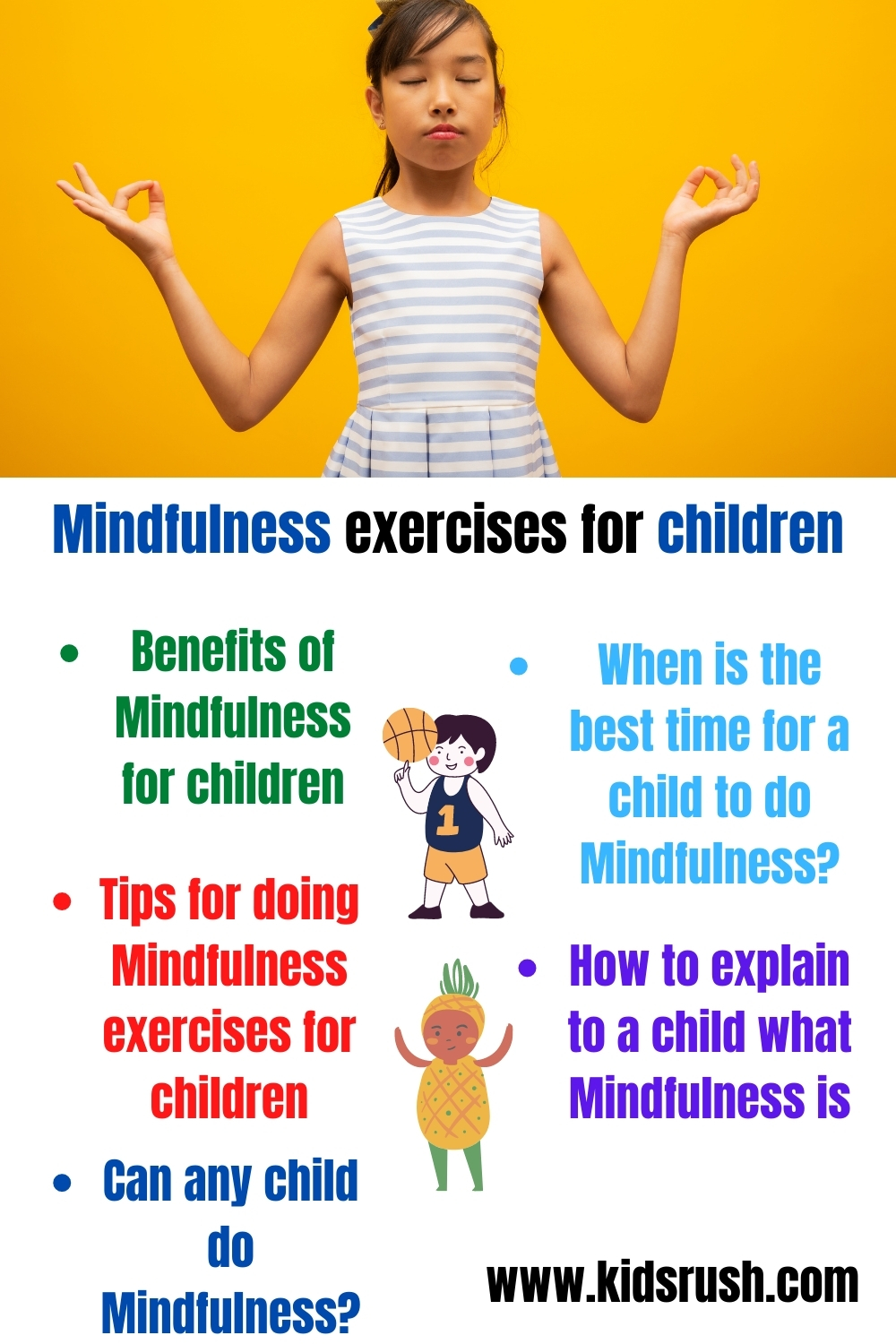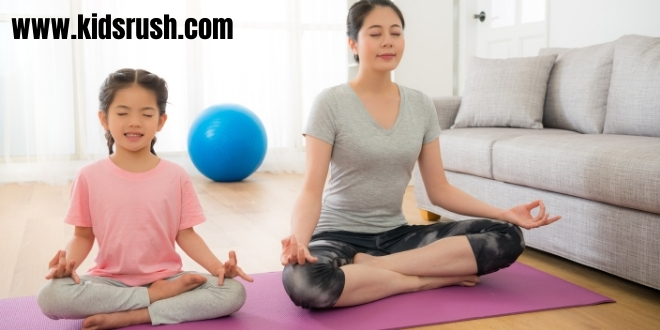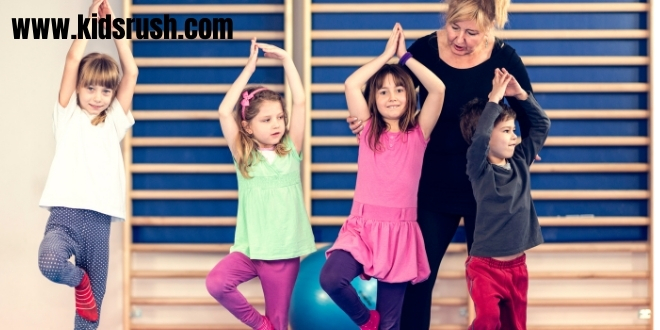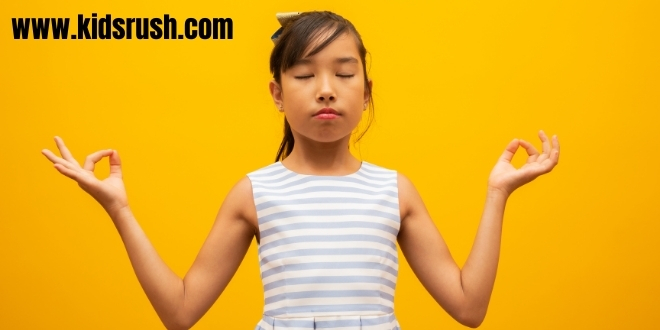Mindfulness exercises for children:
Children’s Mindfulness is a great way for children to learn to pay attention, avoid distractions, balance their emotions, understand their feelings, and feel more self-confident. The benefits of this relaxation technique based on mindfulness are indisputable, so much so that there are even Mindfulness exercises for anxiety.
Introducing this practice into the routine of the little ones requires time, practice, and patience, and each child may respond differently. However, the truth is that it is an easy technique to perform and the benefits are great. Pay attention to this kidsrush.com article where we explain the best Mindfulness exercises for children.

Read Also: Meditation exercises for children
What is Mindfulness
If you are an experienced person in Mindfulness exercises you will know that this practice is made up of a set of exercises that pursue the objective of focusing attention on the present. It helps to be aware of our own inner “I” and to be able to channel negative emotions, in addition to better understanding the feelings and thoughts that haunt our heads all day. With these relaxation techniques, we get to enjoy more of the little things of the day-to-day, to recognize what happens at the moment in which it happens. And you ask yourself, does a 4 or 10-year-old need to acquire all these skills? Find out in the next point.
Benefits of Mindfulness for children

Since we were little we have been taught that sport is an excellent way to instill a series of values, since rules must be followed and requires effort, dedication, and communication with people, as well as respect for them. Playing soccer, basketball, practicing karate or ballet brings physical and psychological benefits to the child, but sometimes leaves aside other emotional dimensions. Therefore, it is interesting that you know what are the benefits of Mindfulness exercises for children:
- Improves attention and concentration.
- Benefits creativity and learning.
- It allows us to control and understand emotions.
- It helps to relax and be calm.
- Develop skills like patience.
- Helps to sleep better.
How about? Do you dare to try it with the kids? In the next section, we explain everything you need to know before starting Mindfulness exercises for children.
Tips for doing Mindfulness exercises for children

Can any child do Mindfulness?
It is recommended that this technique be performed by children from 5 years of age. Each of these exercises can focus on controlling a specific discipline, however, they all try to improve attention and concentration.
When is the best time for a child to do Mindfulness?
Children generally start their day early and finish in the afternoon. They may have homework or classes after school, so avoid proposing to do the exercises when he’s tired or tends to be more irritable. You are the one who best knows the character of your child or students, so you must find the time when they respond best to this type of activity.
How to explain to a child what Mindfulness is
Mindfulness for children is like a paradox. Why? At heart, they are experts in living in the moment. They can enjoy themselves anywhere without worrying. In contrast, adults are prone to easily fall into negative thoughts or concerns while our mind is not distracted. You must convey to the child the need that moments of joy and enjoyment are not only related to activities that require physical energy: running, playing with the ball, etc. but you can also enjoy leisurely activities. Later, with the exercises that we will recommend, it will be much easier for you to understand.
First steps to introduce a child to Mindfulness

These first Mindfulness exercises for children are designed for the first contact of the little ones with this practice.
A discovery
Tell the child that you are going to play a game in which you will discover an object never seen before. Try to have both of you sitting or, in the case of a group, all of you sitting. Take out any everyday object, such as a piece of fruit or food that does not stain. Now you should try to think of various characteristics of the “discovery” using the 5 senses: its weight, touch, smell, shape, if it produces any sound, etc. With this little Mindfulness exercise for children, we will get them to begin to familiarize themselves with the essence of this practice.
Pass the balloon
This exercise is key for the child to understand what Mindfulness is or, at least, to get used to the idea that it does not have to be boring. It consists of passing a balloon from one to the other as quickly as possible. After a minute, we will prove otherwise. We ask you to pass the balloon very slowly from your hands to ours. Then we ask them to describe all the details of the balloon that they could not see when they had passed it so quickly (it is advisable to paint pictures or words on the balloons). Once finished, we must try to make them think that they have a great time quickly, but slowly things can be appreciated that would otherwise go unnoticed.
Mindfulness Exercises for children #1: What’s Playing
In this first Mindfulness exercise for children, we will focus on the sense of hearing. For this, we only need to get hold of different objects that produce different sounds. Then, we indicate that they close their eyes and produce sound with one of the objectives. Afterward, the child must guess which one has made this sound. Easy and fun!
Another easy exercise to perform and similar to the previous one is to fill glasses with different levels of water. Play each one individually, waiting for the previous one to stop playing to start the next one. Ask him to tell you when he stops hearing the sound. This exercise is great for working concentration in an entertaining way.
Mindfulness Exercises for children #2: Visual Memory
If in the previous one we stimulated the ear, in this Mindfulness exercise for children we work on visual memory through two games.
In the first, we take several colorful objects and show them for half a minute so that they remember them. Next, we ask you to close your eyes and remove one of the objects. The child must indicate which is the object that is no longer with the others. In this way, we stimulate observation and memory.
In the second exercise, we are going to try to remember a landscape that we have seen and that we find pleasant: a park, a beach, or any other place. You must close your eyes and try to position yourself in that same place to remember that precise place as accurately as possible. We can even tell you that when you move your mind there, try to touch the objects that are found: trees, rocks, water, etc. This exercise is excellent for working with your imagination and memory.
Mindfulness Exercises for children #3: Absolute Silence
On this occasion, we ask the child or children if they can remain silent for a whole minute or sixty seconds. To better understand this exercise, it is very useful to use an analogy, such as trees or mountains, which are always still. Start the countdown and make sure the children keep their eyes closed and remain silent.
Now we are going to do another Mindfulness exercise for children but focusing all the attention on an object. The child must remain silent, and the goal is for them to contemplate an object with their eyes open, paying attention to the smallest details. After a minute we ask him if he has been able to detect any type of change in the object: color, light, shape, etc. It is advisable to use objects that show slight changes visible: a lava lamp, a candle, an hourglass, etc.
Mindfulness exercises for children #4: The sense of taste
They are sure to love this exercise. We must take a piece of chocolate or any other food that melts in the mouth. The goal is for you to be able to feel the flavor it gives off as it melts and to be able to describe it as if you were telling it to someone who has never tasted that food before. You must first look closely at the food and then let it melt. As the food dissolves, we can tell it to place it in different parts of the mouth to see if the flavor is more or less strong.
Mindfulness Exercise for children #5: Self-esteem

Finally, one of the easy-to-do Mindfulness exercises for children will boost their self-esteem. We must invent a gesture or a set of movements, such as bringing the hands together above the head and lowering them to the navel. In turn, we create a positive phrase that conveys good feelings: Today is going to be a great day, how good I feel helping others, I feel good about myself, I feel happy and content, etc. once both parts have been scheduled, they must be done at the same time, as a greeting. Over time, this could be the Mindfulness exercise to start and end sessions.
Warning
This article is merely informative, at kidsrush.com we do not have the power to prescribe any medical treatment or make any type of diagnosis. We invite you to see a doctor in the case of presenting any type of condition or discomfort.

